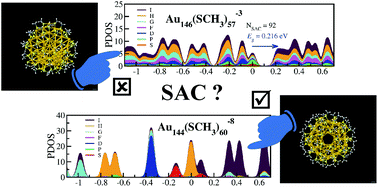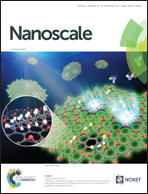Is the largest aqueous gold cluster a superatom complex? Electronic structure & optical response of the structurally determined Au146(p-MBA)57†
Abstract
The new water-soluble gold cluster Au146(p-MBA)57, the structure of which has been recently determined at sub-atomic resolution by Vergara et al., is the largest aqueous gold cluster ever structurally determined and likewise the smallest cluster with a stacking fault. The core presents a twinned truncated octahedron, while additional peripheral gold atoms follow a C2 rotational symmetry. According to the usual counting rules of the superatom complex (SAC) model, the compound attains a number of 92 SAC electrons if the overall net charge is 3− (three additional electrons). As this is the number of electrons required for a major shell closing, the question arises of whether Au146(p-MBA)57 should be regarded as a superatom complex. Starting from the experimental coordinates we have analyzed the structure using density-functional theory. The optimized (relaxed) structure retains all the connectivity of the experimental coordinates, while removing much of its irregularities in interatomic distances, thereby enhancing the C2-symmetry feature. On analyzing the angular-momentum-projected states, we show that, despite a small gap, the electronic structure does not exhibit SAC model character. In addition, optical absorption spectra are found to be relatively smooth compared to the example of the Au144(SR)60 cluster. The Au146(SR)57 does not derive its stability from SAC character; it cannot be considered as a superatom complex.



 Please wait while we load your content...
Please wait while we load your content...